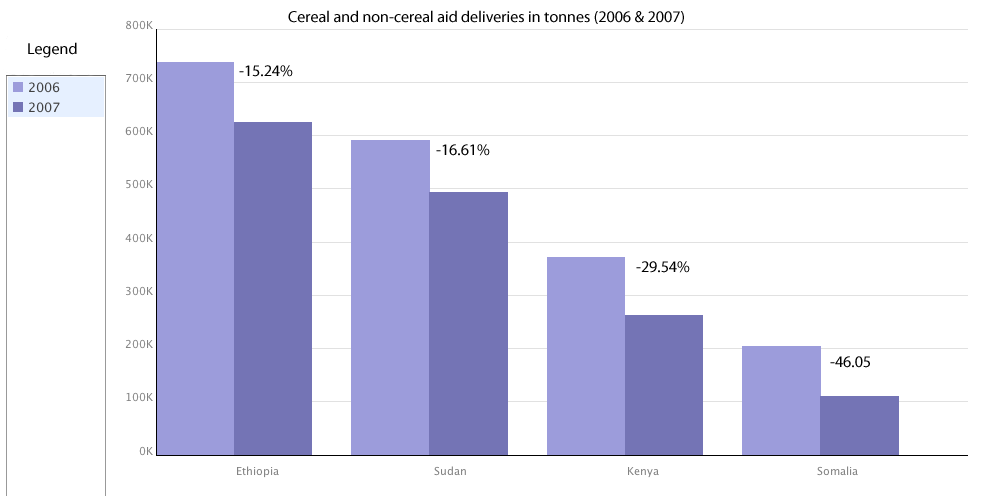Cereal and non-cereal food aid deliveries in tonnes (2006 & 2007)
“Famine looms as wars rend Horn of Africa,” reports that aid will drop as violence increases in Ethiopia, Sudan, Kenya and Somalia. The bar graph illustrates that, between 2006 and 2007, both cereal and non-cereal food aid deliveries did, in fact, decrease in all four countries. The article also cites Somalia as increasingly violent since the collapse of the government in 1991. Somalia saw the most significant drop in aid deliveries, at roughly 46 per cent, in the year leading up to the 2008 famine. The graph shows both a reduction in food aid and a percentage comparison of that drop between countries. Overall, the graph supports the article’s claims that, as violence increases, food aid decreases and can potentially worsen famine conditions.
2007 infant mortality rates per 1000 live births
A world showing infant mortality rates in the year just before the 2008 famine in the Horn of Africa emphasizes the severity of the situation in comparison to the rest of the world. Somalia has the third highest infant mortality rate. Ethiopia, the Sudan and Kenya all fall within the mid to high range of the mortality rate scale. Safia Ali’s child is described as emaciated and Saida Mohamed Afrah leaves her children to find food and returns to discover them dead. These stories are only examples of the state of children just before the 2008 famine. The map helps to emphasize that the main characters in the article are examples of a widespread problem, where children are dying at high rates.
Climate, geography and hunger: Horn of Africa 2007
https://www.google.com/fusiontables/DataSource?snapid=S443811cBPg
The Horn of Africa is a dry and geographically challenging place. The above map allows the viewer to explore the alarming statistics concerning precipitation, cropland and malnourishment for each of the region’s six countries. Perpetually low levels of precipitation—especially in Djibouti and Somalia—plague the region, and only a small percentage of the land can be used to grow crops. Of that small percentage, an almost insignificant amount is maintained as permanent cropland. Without water and land, the population of the Horn of Africa is limited in its ability to grow and cultivate food. As reported in “Famine looms as wars rend Horn of Africa,” diminishing food aid and violence in countries like Somalia and Kenya further complicate these issues. Consequently, the region’s peoples experience intense malnourishment that, as depicted in the article, can lead to starvation and death.





